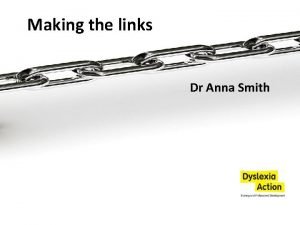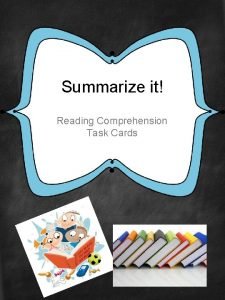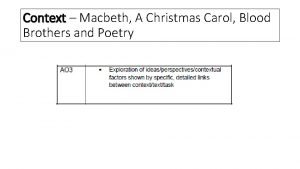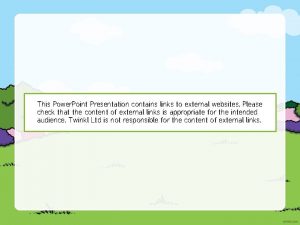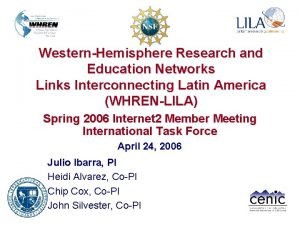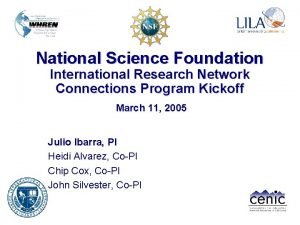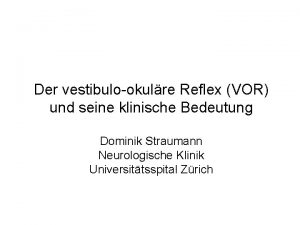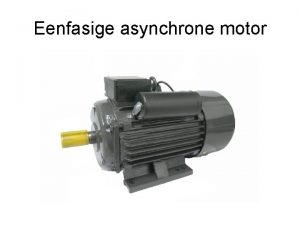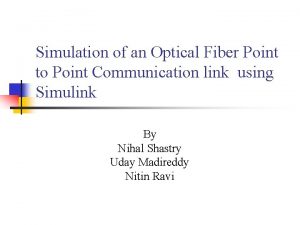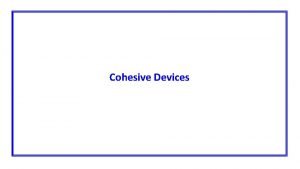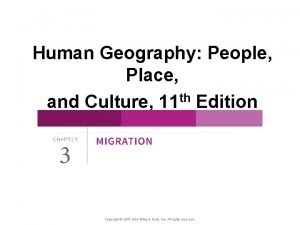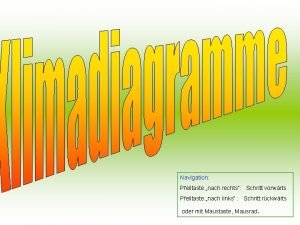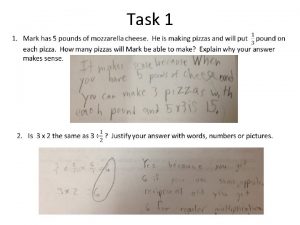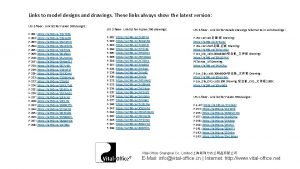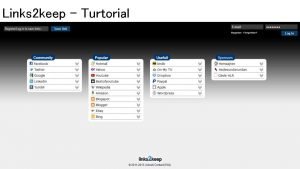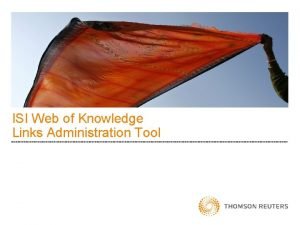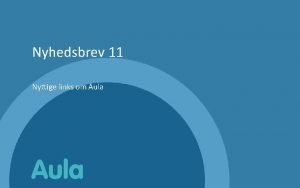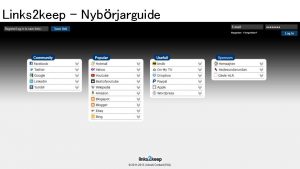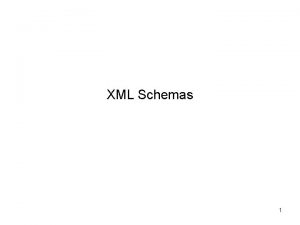Making the links Dr Anna Smith No task

























- Slides: 25

Making the links Dr Anna Smith

No task is ‘pure’ • Neuropsychological functions operate together rather than in isolation • Theoretically, a pure task would lack ecological validity • We need to examine evidence • Certainty is not guaranteed

No single diagnostic test • Dyslexia is heterogenous • No different from other developmental disorders • eg. , ADHD is diverse with several: § Etiological pathways § Clinical presentations § Levels of severity

Two cases of ADHD Case 1: Dan (12) • Born prematurely • low scores on target detection tasks • Academically underachieving • Easy to manage Case 2: Sian (41) • Talks continuously and changes subject • Difficulty keeping job for very long • Several relationships in succession • Impulsive hobbies that don’t last long • Performance is average on most tasks

Dyslexia is also heterogenous • Dyslexia can be heterogenous • We must make judgement on the neuropsychological evidence we have gathered § Test scores § Background information § Qualitative information during assessment • A good assessor will make the links

Reading • Comparison of reading single words and reading in context § Higher scores in tests of comprehension suggest inference when reading in context • Comparison of timed and untimed reading of single words with WRAT and TOWRE 2 § poor reading fluency is more likely to be observed in older children and adults • Comparison with PA subtests § Errors on phonetically plausible words suggest phonological deficits

Spelling • Good readers can be poor spellers § They tend to make ‘phonetic’ errors eg. , spelling cough, as coff § Poor readers and poor spellers make more ‘non-phonetic’ errors eg, spelling cough as coft • Good spelling in DASH tests cannot rule out poor spelling § may be attributable to word selection § Link standard spelling test with spelling in DASH tests • Sound based errors are associated with phonological errors § More often observed in poor readers • Rule based errors are associated with word structure difficulties § More often observed in good readers

Writing • Fine motor problems will be seen in DASH tests § Note handwriting § Link with scores from developmental coordination disorder screening tools § Link with performance on WRIT diamonds but may be specific to handwriting § Compare copy best and copy fast § Free writing may deteriorate over time (qualitative observations important here)

Writing • Language difficulties will be observed in free writing § Compare scores with WRIT verbal subscores § May be consistently poor rather than decline over time • Don’t forget to look at spelling and word choice

Phonological awareness • Subtests may not be equally sensitive: § Elision subtest – involves repetition and allows for other visual strategies § Blending and phoneme isolation are purer measures of PA § Use of supplementary tests containing non-words • eliminates the influence of vocabulary thus a purer test • May be useful in adults • Acceptable for APC as long as case made

Phonological awareness • Scores may not be below average but… § Qualitative analysis important as tests are not timed § Which of the items are difficult: • Compound words: see[saw] - see • Syllables: ri[der] - rye • Onset and rime: ma[n] - ma • Phonemes: tan[k]s - tangs

Phonological awareness § Links can be made with TOWRE 2 (sight word subtest may be better than phonemic decoding subtest) § Links can be made with spelling • more on this later § Links with reading single words • Errors with phonetically plausible real words suggest phonological awareness problem

Phonological memory • Non-word repetition task (CTOPP 2) § CTOPP 2 version does not include many established word patterns § task is purer § Can be indicator of specific language impairment (Bishop 2006) • Link with forwards letters and digits (correlated strongly (Wijsman et al, 2000) § These are established, familiar sounds § If deficit here as well, then more generalised problem with short term memory

Phonological memory • What other clues might you be looking for? § Teacher reports § GORT comprehension subtest – low score may mean less able to maintain information § Specific to phonological information? Compare with manual imitation (TOMAL 2) – visual information may be better held

Working memory • TOMAL 2 is very useful as we can compare directly backwards and forwards scores § Manipulation of letters and numbers may be challenging § Individuals with dyslexia make reversals of number pairs and inversions (6 for 9) • Make links with PA sub-tests: elision requires word to be held and manipulated in WM • Make links with memory for stories (TOMAL 2) § Good for semantic memory

Speed of processing • Typically measured by Rapid Automatic Naming • Not seen in all dyslexic individuals • Possible subtype? • Speed and quality of visual information is compromised • Letter identification is slowed • Links between frequently occurring letters are not made

Speed of processing • May be related to orthographic skill rather than phonemic encoding • May mean slow access to phonological representations rather than visual input (cancellation task) or phonological output (articulation rate) • Regular and irregular words are equally challenging • Further reading: Wolf et al (2000) and Araujo et al (2010), Georgiou et al, 2013 • Links can be made with: § TOWRE: a good measure of reading fluency § WIAT reading speed § If generally slow processing - SDMT – speed of processing

Language difficulties • Background may reveal information: § parental report describes word finding difficulties ‘she knows the answer but she can’t find the word’ § Significant delay in acquisition of first words • Verbal subtest of WRIT may reflect account § requires a qualitative analysis – definitions may involve pointing and using a basic explanation • Analogies subtest of WRIT § a feel for the answer but a difficulty expressing it • Link with low score on phonological memory tests (Bishop 2006)

Language difficulties • Be aware of discrepancy between performance and verbal ability eg. , average versus 70 (Georgopoulos et al, 2003) § strict criteria but useful • Comprehension is often better than production • Qualitative information can be accessed through responses on WIAT (an advantage over WRAT) § Syntax is often impaired § Mean length of utterance is short

Attentional difficulties • Parent and teacher report is crucial here § Inability to concentrate, finish anything, disrupts games • Qualitative observations during testing also important • Use a screening tool to gather information • A great website is http: //www. sdqinfo. org/ • May not be clear indications on tests § Cognitive Variability is hallmark of ADHD § poor motivation, distractability during tests

Making links means comparing scores • Where possible use confidence intervals of 95% but be cautious with these • If you have subtests which differ you can use confidence intervals to be objective • Convert scaled scores to standard or quotient scores • Example: Comparison of digit forwards and manual imitation: § Digit forwards 7 = 85 (SEM is 3) 95% CI is 79 -91 § Manual imitation 10 = 100 (SEM is 3) 95% CI is 94 -106 § No overlap thus confidence performance is markedly discrepant § Avoid use of the word ‘significant’ as you are not performing a statistical test

Single subtests versus composites/ indexes • It can be misleading to focus upon one subtest § Especially if that subtest is not reliable (less than. 9 reliability) • APC preference is for composite scores where appropriate • BUT if subtests within a composite are discrepant, it makes no sense to ‘pool’ scores either § Use outcomes cautiously § Consider reliability of each test § Use qualitative data • If you don’t feel confident, just report composite scores CIs

Table of SEMS for CTOPP-2 and TOMAL 2

Using your own CIs • You may wish to use your own calculations but worry that they differ from those provided in the table • Use footnotes to make it clear *Confidence intervals were calculated using SEMs provided in manual * Confidence intervals were calculated using reliability coefficients provided in the manual

Suggested statements The scores for Test X and Test Y result in the lack of an overlap of the associated confidence intervals of 95%. This discrepancy suggests that the composite score associated with these tests has less meaning than the individual test scores themselves. There is a marked discrepancy between Test A and Test X as defined by the lack of an overlap of the associated confidence intervals of 95%. This suggests that Learner has difficulties with skill A in comparison with skill X It is best to avoid the word ‘significant’ as this implies a formal test of score differences which has not been carried out for these tests.
 Dr anna smith
Dr anna smith Tiered task bias task
Tiered task bias task Making connections task cards
Making connections task cards What is inferring
What is inferring War making and state making as organized crime
War making and state making as organized crime Nide dropbox links
Nide dropbox links How to fix broken links in dreamweaver
How to fix broken links in dreamweaver Laurie kirkland
Laurie kirkland Contextual links in macbeth
Contextual links in macbeth Joints and links
Joints and links Moodle the glen high school
Moodle the glen high school Power point links
Power point links Irnc links
Irnc links Irnc links
Irnc links Apa in a nutshell
Apa in a nutshell Canalolith
Canalolith Kinship links definition
Kinship links definition Join links tables by selecting only the rows
Join links tables by selecting only the rows Inductieve
Inductieve New york links
New york links Optical fiber simulation
Optical fiber simulation What is the example of cohesive devices
What is the example of cohesive devices Periodic movement definition ap human geography
Periodic movement definition ap human geography Doodle fiction examples in the philippines
Doodle fiction examples in the philippines Vorne hinten links rechts
Vorne hinten links rechts Global links and imperialism
Global links and imperialism
